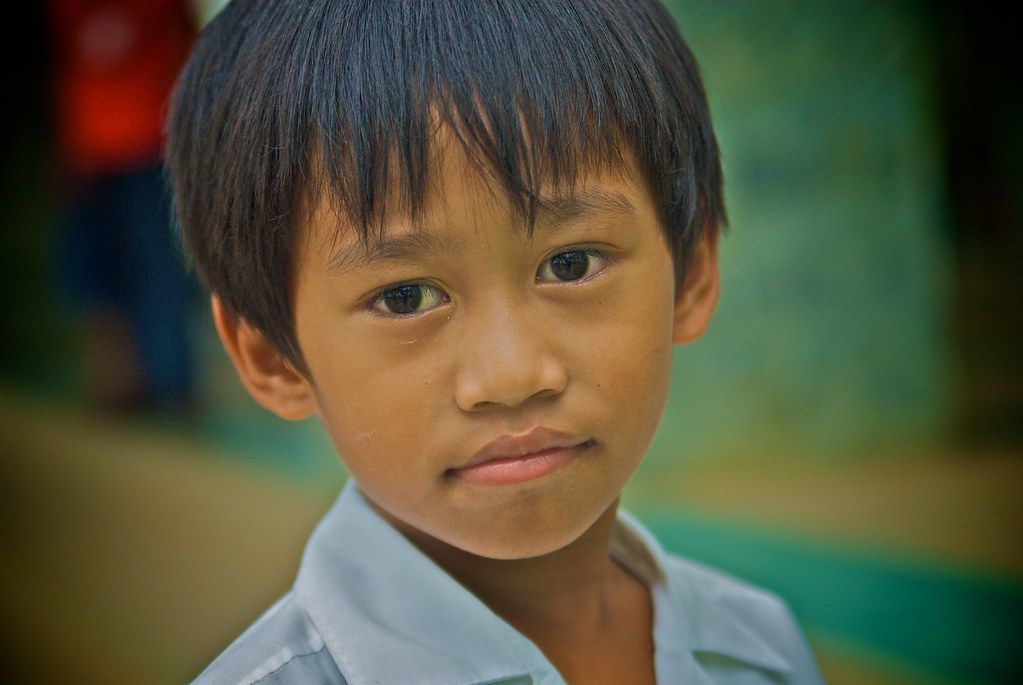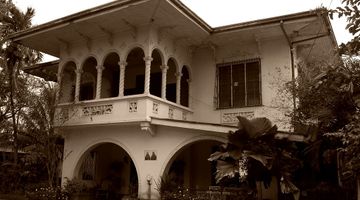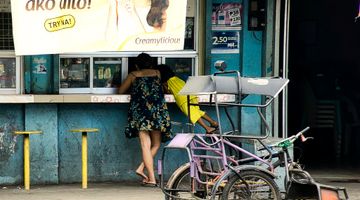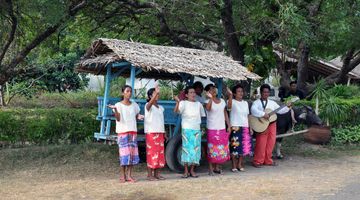Food in the Philippines
Food in the Philippines – recommendations from our local writer Carla
Many tourists don't consider Filipino cuisine worthy of telling people back home which is a shame because although not as popular as that of our neighbouring countries, it is nonetheless rich in both taste and background.
Why Filipino cuisine is considered characterless?
Some people claim it is both bland and greasy, that it's either too oily or too sweet. Having tried authentic dishes of our Asian counterparts, we could say that the stark contrast lies in the fact that none of our main dishes are spicy. Most Filipinos are not fond of eating chili and many have what you'd call a "sweet tooth". We also love our pork and we don't usually have many side dishes or dips.
Other than these differences, we relate to our neighbours in terms of our singular love for rice.
How many meals a day? Three, 5 or more?
Except for those who rely on subsistence farming and lives on corn and root crops, most Filipinos eat rice for breakfast, lunch, and dinner. And oh, we eat on average 5 times a day. In addition to the three main meals, Filipinos also partake in a second breakfast or Segundo Almuerzo at around 10am and merienda or afternoon snack at around 3pm. And then there's also that thing called midnight snack.
Looking into history of Filipino cuisine
So then, what shaped Filipino cuisine into what it is today? Historically, the Philippines were colonized for hundreds of years. We learned various cooking methods and procedures from those colonizers. However, most ingredients in these foreign dishes were either unavailable locally or are simply too expensive. Being naturally adaptive and resourceful, Filipinos utilized the new cooking, preparation, and preserving methods but made use of local ingredients.
From our Chinese ancestors, we inherited noodles and dumplings. We now have a variety of pancit (noodle) dishes such as sotanghon, pancit Malabon, miswa, miki, mami, and bihon.
We also have siomai (dumplings) ,_siopao (steamed pork buns), lumpia ( fried spring rolls), and hopia (mung bean cake), arroz caldo (congee), and fried rice. All Chinese influenced yet very Filipino.
Then the Spaniards came and brought Spanish-Mexican cooking and their love for spices and condiments like peppercorn, bay leaf, garlic as well as soy sauce and vinegar. Their influence was huge in that historians claim that 80% of Filipino Cuisine is derived from Spanish dishes. You can see this in popular Filipino dishes such as adobo, Arroz A La Valenciana, Caldereta, Escabeche, and many more.
From the Americans we got the habit of eating food fast and on the go. Nowadays, you would see fast-food chain in every corner and food park is a steadily rising trend.
Now you understand that Filipino cuisine is essentially a melange of Chinese, Spanish, and American influences. It cannot be conveniently pigeonholed into a single identity or flavour like that of Vietnamese or Thai cuisine. But does that make it less distinct? No. In order to get a proper introduction to Filipino cuisine, one must get an invite into someone's home or spend enough time here to know where to go to get that authentic Filipino cooking. Below is an outline of specialty or regional dishes and where to find them.
Ilocos Region
Ilocanos are fond of vegetables and this is evident in their claim to culinary fame in the form of pinakbet, a vegetable dish consisting of squash, okra, bittermelon, eggplant, tomatoes, and string beans and usually cooked with fermented fish paste or bagoong.
They are also famous for bagnet (deep fried pork), Vigan longanisa (sausage), and dinengdeng (vegetable dish with bagoong and grilled fish).
As a local, we have observed that restaurants serving Filipino food tend to be on the expensive side. Unless you are eating in some carinderia or open air stalls (PHP50 to PHP80), expect to pay on average 150PHP to PHP300 for each dish and between PHP600 to PHP800 for beef or pork dishes like crispy pata or caldereta in fancier restaurants. This is true in most urban cities. Your best bet is to befriend a local and say something like "where to try this dish or that" and more than likely, you'll get an invite to join them for lunch or dinner.
Bicol Region
Bicolano cuisine is unique in that they are fond of coconut milk and chili. If you find yourself here, you must try their laing or pinangat. It is a vegetable dish made with dried taro (gabi leaves), shrimp paste, coconut milk, and chili peppers.
Bicol Express have become synonymous with the region too. It's made out of pork, shrimp paste, and of course the requisite chili peppers and coconut milk. Kinunot is also unique to this region which is basically flaked fish in coconut milk. However, most dishes uses stingray fish so most environmentalist stay away from this dish.
Bulacan
Bulakeños are known for their slow cooking method, often taking advantage of what is caught in the river or brought from the vast farm lands. When you're here, don't miss out on nilasing na hipon (fried shrimp marinated in alcohol), aligasin at dumuko sa tuba (seafood dish cooked with coconut wine), alimango sa misua (crab in thin salted noodles), batute (deep fried stuffed frog), and adobong palaka (stewed frog in soy sauce, vinegar).
Bulacan also specializes in meat dishes such as estofado (stewed pork leg), chicken relleno and galantina (stuffed chicken rolls), kare-kare (simmered tripe and oxtail with vegetables and peanut-based sauce), and asado or pot roast.
Pampanga
Pampanga is every foodie's dream destination especially for the meat lovers. It is not unusual for people to drive hours from Manila on a weekend to indulge in some gastronomic afternoon.
You can do the same and feast on sisig (chopped pig's head and liver seasoned with calamansi and pepper). For the record, celebrity chef Anthony Bourdain said it will "win the hearts and minds of the world". It is best paired with an ice cold beer.
While you're at it, try some exotic dishes like batute tugak (stuffed frog) or camaru ( crickets). Also, get your hands on pindang kalabaw (carabao meat jerky), buro (fermented rice with fish or shrimp), bringhe (paella), and a jar of taba ng talangka (crab roe or fat).
Cordillera Administrative Region
The Cordillera mountains is home to the ethnic tribe of Igorots. Besides their colourful beliefs and cultures, their local cuisine borders on interesting and flavourful to downright controversial.
The pinikpikan, for example, has been in the news because it involves a ritual of repeatedly beating a live chicken with a stick prior to cooking. This practice is believed to make the fowl more flavourful. It's cruel but it doesn't make this chicken dish less popular. You may also help yourself to kini-ing (a smoked or sun-dried pork), sabeng or tengba (soup made from powedered rice, freshwater crab and table salt).
Visayas
The highly urbanized city of Iloilo is home to delicious soups of Pancit Molo (Chinese noodle soup of pork, chicken, or prawn dumplings) and La Paz batchoy (miki noodle soup with pig innards, pork cracklings, and chicken stock). It is also famous for the mouthwatering lumpiang ubod (vegetable eggrolls filled with strips of palm heart sauteed in shrimp or pork).
Bacolod in the meantime is famous for chicken binakol (chicken soup dish with coconut meat and juice) and barbecued chicken. Cebu is lauded for their scrumptious lechon (roasted pig).
Mindanao
The dishes in this region are largely influenced by the Malays and being predominantly Muslim, pork dishes is a rarity.
Zamboanga is where you can enjoy a stick of satti ( spicy grilled beef or chicken) while Lanao del Norte and Lanao del Sur offer rendang (caramelized beef curry), a dish which originated from Minangkabau people of Indonesia. Chicken pyanggang (black coconut chicken) and tiyula itum (burnt coconut beef soup) are both traditional Tausug fares.
Traditional beverages
For drinks that are considered unique to this country, there are a few that are worth a mention.
Sago't gulaman is a cooling beverage made of brown sugar, tapioca pearls , and seaweed gelatine while taho is commonly consumed in the morning. It is a tofu drink with caramelized sugar and sago pearl. Both of these drinks are commonly sold in the street.
For hot beverages, kapeng barako in Batangas is quite popular. It's coffee brewed from Liberica beans and has a strong aroma and distinctive flavour. Salabat or ginger tea is also very comforting during colder months.
For something stronger, we have tuba and lambanog (coconut wine), basi (sugarcane wine), and tapuy (rice wine) from the Cordillera.
Can you learn cooking Filipino dishes?
Not so lacklustre after all, right? Unfortunately, cooking classes geared toward tourists are quite unheard of in this country. There are a number of culinary schools for those working in the food and beverage industry or those who are aiming to get a diploma or certificate but none for transient tourists just trying to learn a dish or two. If you ask around, you'll be advised to get a cookbook or look up YouTube tutorials.

































































